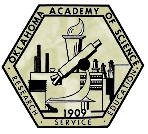
|
 |
|
{Page 93}
William I. Lutterschmidt,1,2 Randall L. Nydam,1,3 and Harry W. Greene4
1 Department of Zoology, 2 Oklahoma Biological Survey, and
3 Oklahoma Museum of Natural History (OMNH), University of Oklahoma, Norman, OK 73019
4 Museum of Vertebrate Zoology and Department of Integrative Biology, University of California, Berkeley, CA 94720
Received: 1996 Feb 23; Revised: 1996 Apr 04
| References | Top of Page | Table of Contents | Home |
Woodland voles, Microtus pinetorum, are found predominantly in the eastern one-half of Oklahoma (1). However, distribution maps in Caire et al. (1) indicate there are 18 eastern counties which do not have locality records for this species; no county records of M. pinetorum have been made for Oklahoma since 1989 (N.J. Czaplewski, pers. comm., OMNH). Here we present the first record for M. pinetorum in LeFlore County, Oklahoma.
We palpated a M. pinetorum from the stomach of a cottonmouth (Agkistrodon piscivorus) collected from Cucumber Creek, LeFlore County, Oklahoma on 22 October 1995. The snake was basking beside a tree stump at ca. 1300 h on the edge of a small feeder stream about 30 in from a beaver dam. Cucumber Creek is a high-gradient upland stream in the Mountain Fork drainage of the Little River system and lies within the Ouachita Biotic District (2). The legal description of our collecting site is SE1/4, NW1/4, Sec. 10, T1N, R25E; the coordinates are 34° 34' 32" N 94° 40' 04" W, or UTM 3827205 M. N, 346997 M. E. The elevation of the site is 335.3 M. (1100 ft.). The M. pinetorum specimen has been deposited into the Museum of Vertebrate Zoology (MVZ) at the University of California, Berkeley (collection identification number: MVZ 184867).
The male cottonmouth (field number HWG 2571, to be deposited in the MVZ, University of California, Berkeley) measured 476 mm in snout-vent length and weighed 123.8 g. The M. pinetorum was swallowed head-first, within a few hours, at most, before capture (no digestive effects visible externally); it weighed 31.2 g, and amounted to 25.2% of the snake's body mass. Cottonmouths eat primarily ectothermic vertebrates but occasionally take rodents, including woodland (pine) voles (3). Our specimen provides evidence of late season feeding on a moderately large prey item. This is a potentially dangerous activity for an ectotherm during cool weather. Because the ability to digest large prey is limited during cool weather, the use of tissuedestructive venoms by vipers may play an important role (4, 5) for late seasonal feeding. The Oklahoma Climatological Survey for Talihina (ca. 32 km from our collecting site) provided minimum, maximum, and mean temperatures (-0.6, 25.6, and 13.4 °C for the 21st of October, and 15.0, 27.8, and 21.0 °C for the 22nd).
We thank C.M. Deen and K. Meier for field assistance, R. B. Channel for verifying the identification of the vole, and V. H. Hutchison for review of this manuscript. We also acknowledge and thank N. Jones and the Oklahoma Chapter of the Nature Conservancy for funding W.I. Lutterschmidt to survey the Herpetofauna of Cucumber Creek.
| References | Top of Page | Table of Contents | Home |
1. Caire, W., Tyler, J.D., Glass, B.P., and Mares, M.A., Mammals of Oklahoma. University of Oklahoma Press, Norman, OK (1989) pp. 567.
2. Blair, W.F., and Hubbell, T.H., The biotic districts of Oklahoma. Am. Midl. Nat. 20, 425-454 (1938).
3. Burkett, R.D., Natural history of the cottonmouth moccasin, Agkistrodon piscivorus (Reptilia). Univ. Kansas Publ. Mus. Nat. Hist. 17, 435-491 (1966).
4. Greene, H.W., The ecological and behavioral context for pitviper evolution. in J.A. Campbell and E.D. Brodie, Jr. (Eds.), Biology of the pitvipers. Selva, Tyler, Texas (1992) pp. 107-117.
{Page 94}
5. Scott, D.E., Fischer, R.U., Congdon, J.D., and Busa, S.A., Whole body lipid dynamics and reproduction in the eastern cottonmouth, Agkistrodon piscivorus. Herpetologica 51, 472-487. (1995).